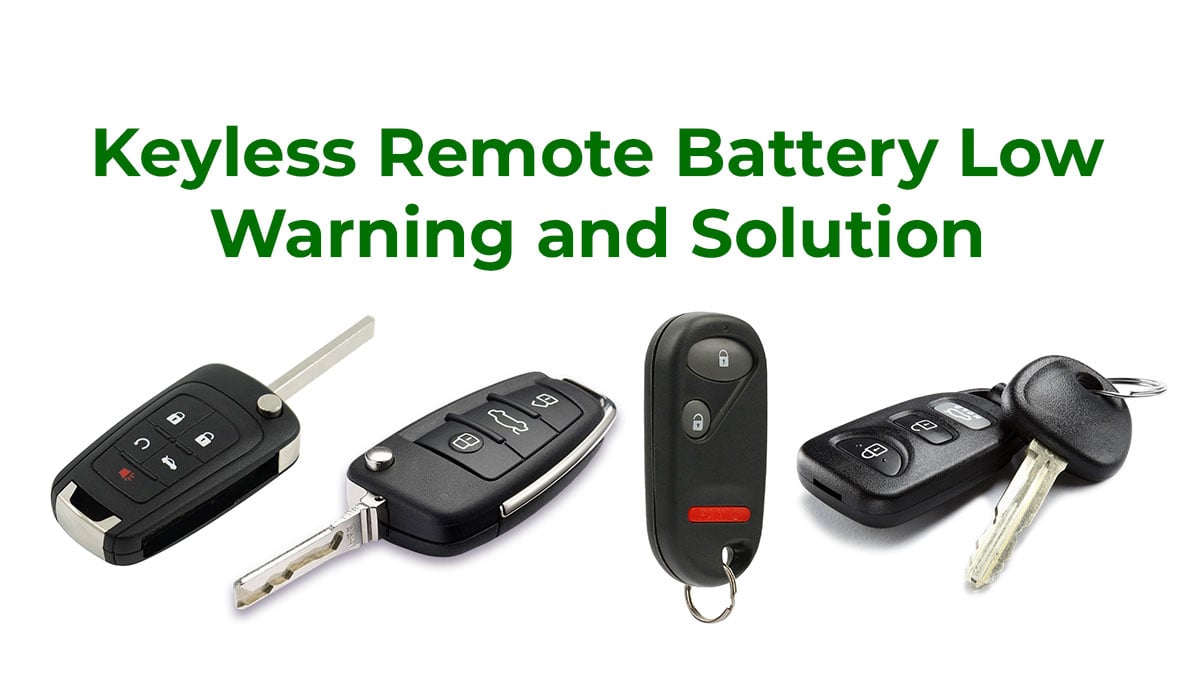Introduction:
In today’s modern world, keyless entry systems have become a standard feature in many vehicles. These systems offer convenience and security, allowing you to unlock and start your car without needing to physically insert a key. However, like all technologies, keyless remote systems are not immune to issues. One common problem that car owners encounter is the “Keyless Remote Battery Low” warning. In this blog post, we’ll delve into the causes, symptoms, and solutions for this issue.
Understanding the Keyless Remote Battery Low Warning:
The keyless remote battery low warning is a notification that appears on your car’s dashboard or center console display. It’s an alert that the battery in your key fob or remote control is running low. It needs to be replaced. This battery powers the communication between your remote and your vehicle. It allowing you to lock, unlock, and start the car with ease.

Symptoms of a Keyless Remote Battery Low Warning:
- Reduced Range: One of the first signs that your keyless remote battery is running low is a reduced operating range. Sometimes if you need to get closer to your vehicle for the remote to work. It’s a clear indicator that the battery is weakening.
- Unresponsive Remote: As the battery depletes further, you might notice that pressing the buttons on your remote doesn’t yield any response from the vehicle. This can be frustrating, especially when you’re in a hurry.
- Delayed Response: A remote with a low battery might exhibit delayed response times. You may need to press the buttons multiple times before the remote successfully communicates with your car.
- Warning Message: Modern vehicles are equipped with advanced onboard computers that can detect the battery status of your key fob. When the system senses a low battery, it will display a warning message on your dashboard.
Causes of a Keyless Remote Battery Low Warning:
Several factors contribute to the draining of keyless remote batteries:
- Usage: The more frequently you use your keyless remote, the faster its battery will drain. High usage can accelerate the depletion of the battery’s energy.
- Battery Quality: The quality of the battery inside your key fob matters. Cheaper batteries might have shorter lifespans, leading to more frequent replacements.
- Environmental Factors: Extreme temperatures, both hot and cold, can impact battery life. Exposure to these conditions can cause the battery to degrade faster.
- Manufacturing Defects: In some cases, manufacturing defects can lead to premature battery failure. If your keyless remote is relatively new and you’re experiencing battery issues, it might be worth contacting the manufacturer.
Solutions:
Dealing with a keyless remote battery low warning is relatively simple:
- Replace the Battery: The most common solution is to replace the battery inside your key fob. Most keyless remotes have easily accessible battery compartments. Consult your vehicle’s manual or a professional for guidance on replacing the battery.
- Use High-Quality Batteries: Opt for reputable and quality batteries when replacing the old one. Spending a bit more on a reliable battery can save you from frequent replacements.
- Reduce Usage: If you notice that your keyless remote’s battery drains quickly, consider reducing its usage when not necessary. This can help prolong battery life.
- Store in Optimal Conditions: Avoid exposing your key fob to extreme temperatures. If possible, store it in a moderate temperature environment.
A keyless remote battery low warning might seem like a minor inconvenience. But it’s an important alert that should be addressed promptly. By understanding the symptoms, causes, and solutions related to this issue, you can ensure that your keyless entry system remains reliable and continues to provide the convenience and security you expect from modern vehicle technology. If you find yourself frequently dealing with low battery warnings, don’t hesitate to replace the battery.

Preventive Measures for Keyless Remote Battery Issues:
While dealing with a keyless remote battery low warning which is part of owning a modern vehicle, there are several steps you can take to minimize the frequency of such issues and prolong the life of your key fob’s battery:
- Regularly Check Battery Status: Make it a habit to check the battery status of your keyless remote periodically. Many vehicles provide information about the battery’s health through the onboard computer system.
- Carry a Spare Battery: Keeping a spare battery in your glove compartment or at home can be a lifesaver when you’re suddenly faced with a dead key fob battery. This simple step can save you from getting locked out of your vehicle.
- Use Keyless Entry Backup: Most vehicles with keyless entry systems also have a physical key hidden within the remote. Familiarize yourself with the location and usage of this key in case your key fob becomes unusable due to a dead battery.
- Key Fob Care: Handle your key fob with care. Avoid dropping it, exposing it to water, or subjecting it to unnecessary physical stress. These factors can impact the battery’s lifespan.
- Battery Replacement Schedule: Consider establishing a routine battery replacement schedule for your key fob. Even if it hasn’t shown any signs of a low battery yet. This proactive approach can prevent unexpected issues and disruptions.
- Keep Your Vehicle Updated: Modern vehicles often receive software updates that can address various issues, including battery-related concerns. Make sure to keep your vehicle’s software up to date to benefit from any improvements in keyless entry technology.
Experiencing a ‘Honda Keyless Remote Battery Low’ warning? Don’t fret! Discover why it happens, how it affects your keyless entry, and step-by-step solutions to get you back on the road without a hitch. Stay informed and empowered with our comprehensive guide.

Final Thoughts:
The keyless remote battery low warning might seem like a minor inconvenience in the grand scheme of things. It underscores the importance of staying attuned to the maintenance needs of your vehicle’s advanced features. By understanding the causes, symptoms, and solutions for this common issue, you can take proactive steps to ensure that your keyless remote functions reliably and efficiently.
Remember, your vehicle’s keyless entry system is designed to enhance convenience and security. But it’s only as effective as its power source. As you are following the tips outlined in this blog post and incorporating them into your routine vehicle maintenance. Now you can avoid unexpected key fob battery issues and continue enjoying the benefits of modern automotive technology hassle-free.
Exploring Advanced Keyless Entry Solutions:
Technology continues to evolve. Keyless entry systems are also undergoing advancements to address the challenges and limitations of traditional key fobs. Let’s take a look at some emerging keyless entry solutions that aim to make your driving experience even more seamless:
- Biometric Keyless Entry: Imagine unlocking and starting your car with just a touch of your finger or a scan of your iris. Biometric keyless entry systems are gaining traction, offering enhanced security by using unique biological identifiers to grant access to your vehicle.
- Mobile App Integration: Some vehicle manufacturers are moving towards smartphone app integration for keyless entry. With this technology, your smartphone becomes your digital key. You can lock, unlock, and start your car using an app, eliminating the need for a physical key fob altogether.
- Proximity Sensing: Future keyless entry systems might rely on proximity sensing technology, allowing your vehicle to detect your presence and automatically unlock as you approach. This technology aims to further streamline the entry process.
- Wireless Charging Key Fobs: As the world transitions to wireless charging, key fobs might follow suit. Wireless charging key fobs could eliminate the need to replace batteries altogether, providing a more eco-friendly and convenient solution.
- Gesture Control: Some automakers are experimenting with gesture control technology. This allows you to perform specific gestures, like waving your hand, to unlock or lock your vehicle. While still in the early stages, this technology has the potential to redefine how we interact with our cars.
Looking Ahead- Future Innovations and Considerations:
As we peer into the future of keyless entry systems, several trends and considerations are shaping the landscape:
- Security Enhancement: As technology progresses, so do potential security vulnerabilities. Manufacturers are investing in robust encryption and authentication methods to safeguard keyless entry systems from hacking and unauthorized access.
- Integration with Smart Homes: The convergence of automotive technology with smart home ecosystems is gaining momentum. Imagine a seamless transition from your smart home to your smart car, where doors unlock, climate settings adjust, and music preferences sync automatically as you approach your vehicle.
- Multi-Modal Biometrics: Future keyless entry systems might combine multiple biometric factors for enhanced security. This could include facial recognition, fingerprint scanning, and voice recognition, making unauthorized access nearly impossible.
- User Customization: Personalization is a key theme in modern technology. Future keyless entry systems could adapt to individual preferences, adjusting seat positions, climate settings, and infotainment options based on the detected user.
- Energy Harvesting: To address concerns about battery life, some researchers are exploring energy harvesting technologies. These systems could draw energy from the environment, such as solar power, to charge key fob batteries.
- Regulatory Changes: The automotive industry is subject to regulatory changes, and keyless entry systems are no exception. As safety and environmental standards evolve, keyless entry technologies may need to adapt to meet new requirements.

Embracing the Journey:
The “Keyless Remote Battery Low” warning is a reminder that technology is ever-evolving, pushing boundaries and redefining convenience. As we transition from traditional keys to innovative keyless entry systems, it’s essential to stay open to change and be prepared to adapt to new ways of interacting with our vehicles.
The journey from the first keyless entry systems to the future of biometrics, smart integration, and energy-efficient solutions is an exciting one. By understanding the challenges, embracing the solutions, and eagerly anticipating the innovations that lie ahead, you’re not just responding to a battery warning; you’re participating in the ongoing narrative of automotive evolution.
So, the next time you encounter that “Keyless Remote Battery Low” warning, take a moment to appreciate how far we’ve come and how much further we can go in the realm of keyless entry technology. Your vehicle’s keyless entry system is not just a functional tool; it’s a testament to human ingenuity, curiosity, and the desire to make everyday experiences extraordinary.
Empowering the Driver: Your Role in Keyless Entry Care:
In this era of advanced automotive technology, you, the driver, play a pivotal role in ensuring the optimal performance and longevity of your keyless entry system. Here are some actionable steps you can take to empower yourself in this tech-driven journey:
- Stay Informed: As technology evolves, staying informed is key. Keep an eye on updates from your vehicle manufacturer, read about new developments in keyless entry, and follow best practices to maximize the lifespan of your key fob’s battery.
- Proactive Maintenance: Regular maintenance isn’t just for the engine and tires; your keyless entry system deserves attention too. Include battery checks and replacements in your vehicle’s maintenance routine to avoid surprises.
- Tech Literacy: Take the time to understand the features and functions of your keyless entry system. Familiarize yourself with the user manual and online resources to troubleshoot basic issues and make the most of the system’s capabilities.
- Adapt to Change: As new keyless entry technologies emerge, be open to embracing change. While it might feel unfamiliar initially, adapting to innovative systems can enhance your driving experience and simplify your interactions with your vehicle.
- Environmentally Conscious: As we look to the future, consider the environmental impact of your choices. Opt for eco-friendly battery options, recycle used batteries responsibly, and support advancements in energy-efficient keyless entry solutions.
Closing Thoughts: A Journey of Evolution:
From the early days of traditional keys to the cutting-edge biometric, the journey of keyless entry technology is a testament to human creativity and progress. The “Keyless Remote Battery Low” warning is a gentle reminder that as we embrace the future, we should also appreciate the history and innovation that have brought us here.
So, the next time you encounter that familiar warning on your dashboard, take a moment to reflect on the remarkable journey of automotive technology. From the mechanical click of a physical key to the seamless wave of a hand, the evolution of keyless entry systems reflects our constant pursuit of convenience, security, and a more connected world.
Embracing the Future: A Unified Driving Experience:
As we conclude this exploration of the “Keyless Remote Battery Low” warning and the fascinating world of keyless entry technology, it’s important to recognize that this is just one chapter in the larger narrative of automotive innovation. The journey from mechanical keys to sophisticated keyless systems reflects a broader shift towards creating a unified driving experience that seamlessly integrates technology into our daily lives.
In this interconnected age, where vehicles communicate with smartphones, homes, and even other vehicles, keyless entry is emblematic of the broader shift towards smart mobility. As we continue to navigate this transformative era, it’s essential to approach each technological challenge with curiosity and a willingness to learn. By doing so, you’re not just troubleshooting a low battery warning; you’re actively participating in shaping the future of how we interact with our vehicles.
So, whether you’re marveling at the convenience of unlocking your car with a touch, pondering the intricacies of biometric security, or considering the impact of energy-efficient solutions, remember that you’re part of a generation that’s rewriting the rules of driving and transportation. With every advancement, we move closer to a world where our vehicles are not just modes of transportation, but extensions of our digital lives.
A Journey of Possibilities:
As the “Keyless Remote Battery Low” warning continues to prompt us to address battery issues promptly, let it also serve as a reminder of the journey we’re on. It’s a journey filled with challenges, discoveries, and the relentless pursuit of excellence. From battery-powered fobs to energy harvesting systems, from physical keys to biometric identifiers, the evolution of keyless entry encapsulates the spirit of innovation that drives the automotive industry forward.
So, as you navigate the roads of tomorrow, remember that the “Keyless Remote Battery Low” warning is more than just a notification—it’s a symbol of our ongoing exploration, adaptation, and quest for a safer, more connected, and more exhilarating driving experience. Embrace the evolution, revel in the possibilities, and drive towards a future where technology and driving seamlessly merge to create something extraordinary.






